Clonmeen House
Houses within 10km of this house
Displaying 43 houses.
Houses within 10km of Clonmeen House
Displaying 43 houses.
| House name | Description | |
|---|---|---|
| Longueville House | Longueville House was the seat of the Longfield family, built in 1720. Wilson, writing in 1786, refers to it as the seat of John Longfield. In the 1850s it was valued at £56 and held by Richard Longfield from the representatives of Charles P. Coote with a demesne of 312 acres. The Longfields sold Longueville to Senator William O'Callaghan in 1938. The Irish Tourist Association survey of the 1940s claims that the original lands were taken from the O'Callaghans after the 1641 rebellion and granted to Sir Nicholas Purdon. Longueville is now a country house hotel. |

|
| Greenfield | In 1814 occupied by William Allen and at the time of Griffith's Valuation Michael Boyan was resident. He held the property valued at £10+ from Richard O. Aldworth. Colonel Grove White writes that Boyan bought Greenfield from the Allens in 1840 in the Court of Chancery and that he made the house larger. Michael Boyan of Greenfield, Kanturk, owned 570 acres in county Cork in the 1870s. This house is extant and occupied. | |
| Lohort Castle | A 15th century tower house, restored by the Perceval family, Earls of Egmont, in the mid 18th century and inhabited by their agents. At the time of Griffith's Valuation held by the Earl in fee and valued at £27. Remodelled in 1876, the castle later became the home of Sir Timothy O'Brien, baronet, and in 1906 he was recorded as the occupier. The building was burnt in July 1921 just before the War of Independence ended when it was the residence of Sir Timothy O'Brien. It was partly restored. The Irish Tourist Authority Survey reported in 1944 that it was the residence of James McCabe who had purchased it in 1925. It is still inhabited and in 2011 it was advertised for sale. |
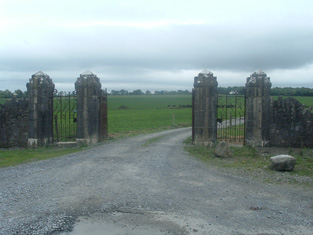
|
| Mill View | A five bay three storey house built about 1800, with some modern additions. At the time of Griffith's Valuation held by Sir Edward Tierney in fee, the buildings were valued at £19+. |

|
| Egmont Villa | A house occupied by Neptune Blood in the mid 19th century. He held the house valued at £19 from Sir Edward Tierney. Restored in the 1980s by Patrick Callaghan and still extant. | |
| Gortmore House | A late 18th century or early 19th century two storey house, the home of the Foote family in the 19th century. Occupied by Mr Thomas Clarke in 1814, by Edward Foote in 1837 and at the time of Griffith's Valuation. He held the house and demesne from Viscount Lismore. It is labelled Gortmore Castle on the 1st edition Ordnance Survey map but as Gortmore House on the later 25-inch edition of the 1890s. It is still extant. |

|
| Ballygiblin | This was the seat of the Becher baronets in the 19th century. Occupied in 1814 by Beecher Wrixon and in 1837 recorded by Lewis as "recently modernised" [William Morrison]. Sir William W. Beecher held Ballygiblin in fee at the time of Griffith's Valuation when it was valued at £52. The seat of Sir John Wrixon Becher in 1894 and still occupied by the Bechers in 1906. In 1944 the Irish Tourist Association Survey reported that it was owned by D.CMurphy and J. Lombard. The report contains detailed background to the Beecher family including the story of Lady Beecher, the actress, Elizabeth O'Neill. This house is now a ruin. |
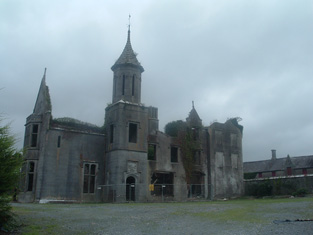
|
| Assolas | Built by the Reverend Francis Gore (died 1748) in the early 18th century and occupied by Philip Oliver circa 1750. This house was the home of the Wrixon family from 1774. Occupied by William Harris in 1814 and by Sir William Wrixon Becher in 1837. Richard Smith was resident in the mid 19th century, holding the property then valued at £25+ from Sir William W. Beecher. Owned and run as a guest house by the Bourke family until 2005. In 2022 it was offered for sale. |

|
| Bettyville | Charles Bastable lived here in the early years of the 19th century. The house was occupied by John Therry in 1837 and in the mid 19th century, when valued at £11 and held from Anne Westropp. Bettyville was part of the Creagh estate for sale in July 1853 when it was held by the representatives of Thomas Bennett. Very little remains of this house. | |
| Coolnahane | A house situated on Viscount Lismore's estate and occupied by Jeremiah Leane at the time of Griffith's Valuation when it was valued at £10. It is named Coonahane House on both the 1st and 25-inch edition Ordnance Survey maps. A house is still extant at the site. | |
| Killavallig | A building is marked in this townland on the first Ordnance map. A house valued at £14 is recorded at the time of Griffith's Valuation, occupied by Michael R. Mackey and held from Charles Purcell. A house is still extant at this site. | |
| Rathmaher | Originally a Purcell home which was advertised for sale in May 1850. By the time of Griffith's Valuation this house was owned and occupied by Thomas Wise, valued at £33. In 1944 the Irish Tourist Association Survey reported that this house had been built c.1800 by John Purcell originally of Highfort. It was later occupied by Walpole and Smith families. This house is now a ruin. | |
| Gurteenard | A late 18th century house on the Purcell estate, the home of the Collins family in the early 19th century. Occupied by Daniel Bastable in the mid 19th century and held from William Collins. The buildings were valued at £14+. The house was still in Bastable ownership in 1906. |
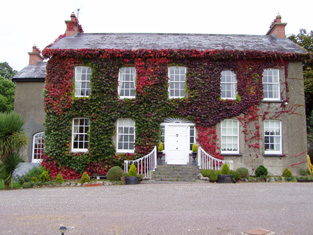
|
| Allowdale | A house valued at almost £12 in the mid 19th century, held by Daniel McCabe from the Earl of Egmont, now a ruin. | |
| Dromagh Castle | In 1815 Smith refers to Mr Philpot inhabiting Dromagh. A seat of the Leader family in the 19th century, Lewis writes that the castle was once the chief residence of the O'Keeffes. In 1906 buildings at Dromagh were valued at £27 and William N. Leader was the occupier. Donnelly states that it was burnt in March 1921 during the War of Independence. It is now a ruin. |
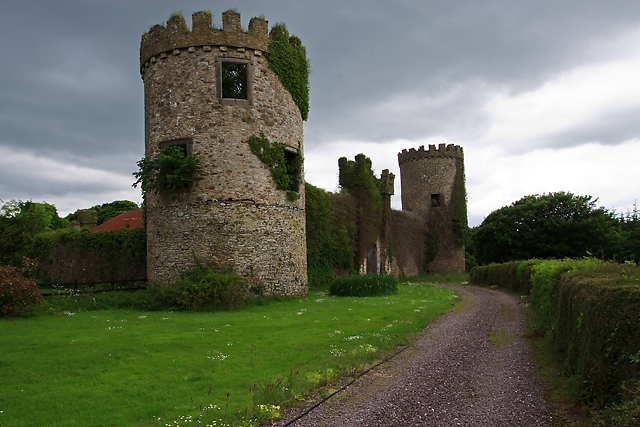
|
| Dysert | A house valued at £12 and held by Nicholas P. Leader in fee at the time of Griffith's Valuation. This house was still in Leader occupation in 1906. A house and farm are still extant at the site. | |
| Fort Grady | Located on the O'Grady, Viscount Guillamore estate, Fort Grady was valued at £14 in the mid 19th century and occupied by John O'Connell. In 1837 Lewis describes it as a farm house formerly the residence of the father of Viscount Guillamore. In 1814 it was occupied by Mr Daniel McAuliffe. In 1786 Wilson refers to it as "Knockbrack, the seat of Mr. Gredy". A house and farm are still extant at the site. | |
| Nashville/Rosnalee | This house was originally known as Nashville and was the home of the family of that name in the 18th century. Wilson refers to it as Nashville, the seat of Mr. Nash, in 1786. It passed by marriage to the Leader family. Nicholas P. Leader occupied the house in 1814. It was still known as Nashville in 1837 but is marked on the first Ordnance Survey map as Rosnalee. Valued at £51 at the time of Griffith's Valuation it was held by William Leader in fee and he had a flour mill nearby valued at £45. The Leaders still occupied this house in 1921. In 1943 the Irish Tourist Association Survey noted it as having been the chief seat of the Leaders, a two-storey spacious structure which was then unoccupied. It is no longer extant. | |
| Ballyphilibeen | A building is marked on the first Ordnance Survey map in this townland. By the time of Griffith's Valuation Prudence Twinhan was living in a house valued at £14 and held from Thomas Wise with 225 acres. | |
| Castlecor | The home of the Freeman family purchased from the Chinnerys in the early 18th century. Smith records it as the seat of William Freeman in 1750 and Wilson describes it as "the fine seat of Mr.Freeman" in 1786. Later the home of the Deane Freeman family who enlarged the building at the beginning of the 19th century. Advertised for sale in 1852, Bence Jones writes that it was bought by Richard Barry. It remained in the Barrys' possession until the 1950s. In the 1940s the Irish Tourist Association survey noted that "the house and offices are now rather neglected". Sold by Mr Hope Murray in the 1960s and subsequently demolished. | |
| Marybrook | This was originally a tower house with additions from the mid 18th century. Occupied by Edward H. Reardon in the first half of the 19th century and by John O'Connell in the mid 19th century, when it was valued at £11 and held from Bartholomew Gibbings. In the sale rental of May 1860 this house was describes as in "thorough repair" and leased to John Connell for 100 years from 1851. In the 1940s the Irish Tourist Association Survey reported that it was then the residence of the Cronin family. It is still extant and in use. |
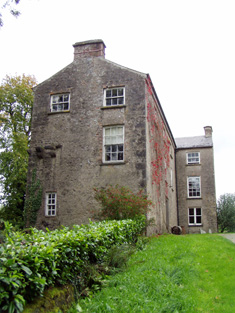
|
| Castle Park | At the time of Griffith's Valuation this house, valued at £41, was held by Sir Edward Tierney in fee. Still in use as a private residence, in 2014 it was offered for sale. |

|
| Park House | Occupied by Maurice Barry and held from Sir Edward Tierney in the mid 19th century when the buildings were valued at £12+. William F. S. Barry was the occupier in 1906. It is still extant. | |
| Park | A house valued at £18+ in the mid 19th century and held by Sir Edward Tierney in fee. A house is still extant at the site. | |
| Killeenleagh | No demesne was marked in this townland on the first Ordnance Survey map but a house valued at £15+ was situated there by the time of Griffith's Valuation. It was occupied by Richard O'Callaghan and held from the Earl of Listowel. | |
| Spring Grove | This house was the home of Arthur Bastable in 1814. This house was part of the Creagh estate for sale in July 1853, Christopher Carleton, "a lunatic", was the leasee. Unoccupied at the time of Griffith's Valuation when valued at £9.10 shillings. The representatives of Thomas Harris were the immediate lessors. A house is still extant at the site. | |
| Roskeen | The home of the Power family which was held from the Kingston estate. Pierce Power occupied the house in 1837 and John Power in the early 1850s when the buildings were valued at £24. Arthur Irwin was the occupier of this house in 1906 and it is still lived in. |
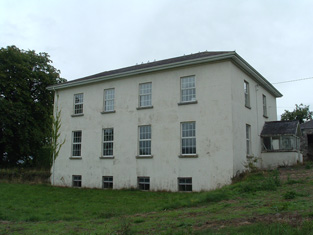
|
| Mountnorth Court | Described by Smith in the mid 18th century as a square building with two wings and fine plantations. In 1786 Wilson refers to it as "the fine and magnificent seat of Lord Lisle, with ample demesnes". This house is described as "in ruins" on the first Ordnance Survey map and modern farm buildings exist at the site now. | |
| Subulter | Leased at the end of the 18th century to James Leahy by the Lloyds. Occupied by John Leahy in 1837 and by Richard Leahy in the early 1850s who held the house valued at £18+ from Thomas Lloyd. Later owned by the Warrens of Codrum House. A new house now stands on the site. | |
| Ballythomas | Originally a Crofts home, leased to the Bullen family by the mid 18th century. Occupied by Robert C. Bullen at the time of Griffith's Valuation. He held the house valued at £12+ and 111 acres in fee. The Crofts appear to have resumed possession in the late 19th century. Home of the O'Connors in the 20th century. |
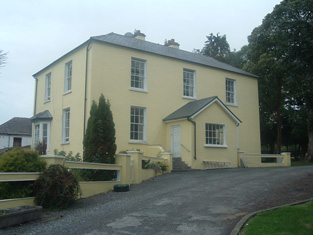
|
| Waterloo | Reputedly built circa 1815 for Henry Longfield, fifth son of John Longfield of Longueville, following his marriage to Mary Powell, heiress of Sea Court, county Cork. At the time of Griffith's Valuation it was held by Henry Longfield in fee and valued at £37. Henry's son John Powell Longfield sold Waterloo to his first cousin Richard Longfield of Longueville who left it to his third son Augustus Henry Longfield. Augustus H. Longfield extended the building. The house was sold to Mr E. W. Hope-Johnstone in 1946. It is still a fine residence. |

|
| Summerville | Originally a Purdon house situated on the Coote estate and described by Smith as a "neat lodge" in 1750. It was home to members of the Chapman and Nason families. Occupied by John Nicholas Wrixon in 1837. Valued at £14 in the early 1850s when it was occupied by Kenny Herbert. Still occupied and surrounded by mature woodland. |
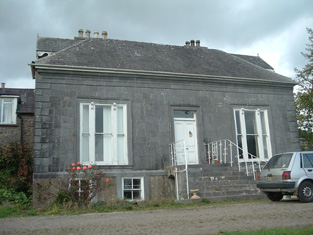
|
| Woodpark | This property belonged to the Wrixon family in the 18th century. In 1814 it was occupied by T. Callaghan. In the mid 19th century James Carmichael was in residence. He held it from the representatives of Charles D. Purcell. The buildings were valued at £11.10 shillings. Hajba writes that the Carmichaels later purchased the property from the Purcells. It is still an occupied residence. | |
| Aldworth | Hajba writes that this house was occupied by members of the Bolster family who held it from the Newmans in the late 18th century. It then became a Lombard property and passed from them to a relative, James Hunt. In the early 1850s it was occupied by James Laurence Cotter, held from James Hunt and valued at £14. This house is still occupied. Another house close by named Aldworth Lodge was also a Bolster home valued at £4+ at the time of Griffith's Valuation. A house is also extant at the latter site. |

|
| Lombardstown House | The seat for many years of the Lombard family, built in the mid 18th century. In 1750 Smith refers to the house as "lately built by James Lombard". From the 1830s it was leased to the Bolster family. George Bolster held the house valued at £15 plus a demesne of 101 acres from Lady Cotter in the early 1850s. The Bolsters remained in residence until the late 19th century when they sold their interest to Henry G. Smith. His descendants continue to occupy the house (Hajba). |

|
| Ballyclogh Castle | At the time of Griffith's Valuation Thomas Haines and Son owned a house, corn and flour mill and offices in the townland of Ballyclogh valued at £82. This property was held with 4 acres from the representatives of C.P. Coote and John Wrixon. In 1906 Ballyclogh was occupied by the representatives of Charles P. Coote. The house was located adjacent to a medieval tower house. Both the house and mill are now in ruins. | |
| Blossomfort | Hajba refers to John Wrixon of Blossomfort in 1703. Wilson, writing in 1786, refers to Blossom-fort as the seat of Mr. Wrixon. The present house, occupied by William Bullen in 1814 and by J. Smith in 1837 was built by the Wrixons probably in the early 19th century. In the mid 19th century Blossomfort was the residence of Thomas Haynes who held the property from Benjamin Wrixon. It was valued at £14. Sold by the Wrixons to the Longfields of Longueville, Blossomfort became the residence of their agent, Richard Smith. This house was reconstructed following a fire in the early 1900s and is still extant. |
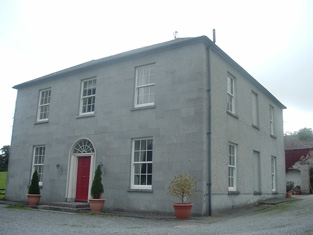
|
| Cecilstown Lodge | A home of members of the Wrixon family in the late 18th and early 19th centuries. Occupied by William Wrixon, father of Sir William Wrixon Becher, in 1837. It was leased to Thomas Heffernan from the 1840s. Valued at £9 in the early 1850s it was later occupied by members of the clergy including the Reverend E.G. Jones, whose widow bought the house in the early 20th century. It was burnt in June 1921 during the War of Independence when it was the residence of the sisters, Esther Jane and Annie Jones. A house, however, still exists at the site. | |
| Kilpatrick | Hajba writes that Roger Langley leased this property from the Longfields in the mid 18th century. Lewis writes that William J. McCormick, medical doctor,occupied the house in 1837. A boys' school was established at Kilpatrick by the McCormicks. At the time of Griffith's Valuation William J. McCormack held the house valued at almost £10.15 shillings from Christopher Langley. Sir William J. MacCormac was a well known London surgeon, the son of Dr Henry MacCormac of Belfast. The house was occupied until the early 20th century but is now a ruin. | |
| Rockfield | A Nash home in the first half of the 19th century, occupied by Christopher Nash at the time of Griffith's Valuation and held from John James Nugent. The buildings were valued at £7. In the 1940s the Irish Tourist Association Survey noted that this property had once belonged to a family called Badham but was afterwards acquired by the Nashs and that "the present house was probably built by the latter family". A house and substantial farm are still extant at Rockfield. | |
| Clonmeen Lodge | Hajba writes that this house was the home of Cornelius O'Callaghan in 1750. In 1786 Wilson refers to "Bantyre" as the seat of Mr. Callaghan. Viscount Lismore is recorded as proprietor of Clonmeen in 1814. At the time of Griffith's Valuation Clonmeen Lodge was occupied by George Grehan and held from Viscount Lismore. It was valued at £7+. The Grehans continued to use this house as a secondary residence while their main residence was in Dublin. In 1893 a much larger house, Clonmeen House, was built close to the lodge. In the 1940s the Irish Tourist Association Survey noted "The Lodge, Banteer" as the residence of Jerome O'Callaghan and stated that the house had originally been built by the Nash family as a fishing lodge. A building is still extant at the site. | |
| Springville | Originally owned by a family named Minton who sold the property to the Wises of Cork city in the 1840s. It was then leased to Charles Daly who occupied the house valued at £5 at the time of Griffith's Valuation. Grove White writes that Daly spent a large sum of money reconstructing the house. Later occupied by O'Briens and Bolsters, still extant and lived in. |

|
| Gortmore Cottage | At the time of Griffith's Valuation, Gortmore Cottage was occupied by Roger O'Callaghan, leasing from Reverend Phillip Townsend, when the house was valued at £11. In the 1940s the Irish Tourist Association Survey noted that the original house had burnt down in 1911 and a two-storey house was then occupying the site. |

